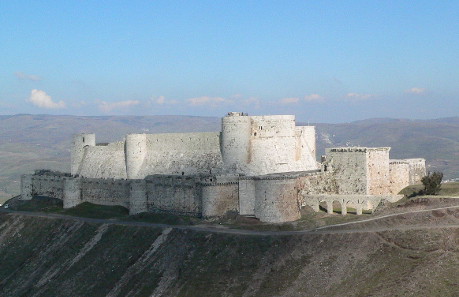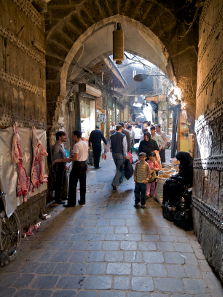by Björn Schöpe
July 31, 2014 – The violence does not stop in the Middle East. Syria and Iraq in particular descend into anarchy caused by civil war. And, of course, the first victims are the civilians.
But besides there is another victim whose suffering will reveal disastrous consequences one day: the culture. To both countries alike, Syria and Iraq, their cultural past means a key factor of integration to the numerous religious and ethnic communities. At the same time the historical monuments attract tourists and tourism is one of the main economic sectors of these countries.
The continuous fighting damages this cultural heritage seriously or even beyond repair. Volunteers apply their energy to the task of recording these dire events and make them public. Otherwise we would know even less about it abroad.
The Krak des Chevaliers in 2005 before its being heavily damaged.
A particular prominent case is the important crusader castle Krak des Chevaliers nearby Homs, one of Syria’s six UNESCO World Heritage Sites. Rebels occupied this mighty fortress and were bombarded by the Syrian air force subsequently. Eventually the army took the medieval castle but the monument became a ruin in the course of this action.
The Temple of Bel in Palmyra. http://creativecommons.org/licenses/by-sa/3.0/
A similar fate befell the famous ancient Temple of Bel in the desert city of Palmyra. Two columns fell and the ruins were damaged.
In 2010 the minaret of the Great Mosque of Aleppo looked like this. Photograph: yeowatzup / http://creativecommons.org/licenses/by/2.0/deed.de
The Great Mosque of Aleppo lost its minaret of 50 meter height in the fight between rebels and the regular army. The minaret dates back to 1095 and was a landmark of the city. Students carried the stones of the monument to a deposit with the hope that one day they may be reassembled again. Until now the war parties are blaming the other on that regard.
The Suq of Aleppo in 2010. Photograph: Dirk D. / http://creativecommons.org/licenses/by-sa/3.0
The fire that, in 2012, transformed the suq of Aleppo into ruins made headlines. The twelve kilometres of streets full of warehouses and stores were considered one of the most beautiful markets of the Islamic world and are also a UNESCO World Heritage Site.
However, it appears that these were ‘only’ ‘collateral damages’ and hazarded consequences. Almost more sinister is how the Islamistic movement ISIS (Islamic State in Iraq and Syria) operates. Even cultural objects have come into their firing line. Footage shows hooded men spoiling objects of art hundreds of years old or blowing up complete monuments. The Sunni ISIS combatants aim particularly for Shiite shrines. But even mosques and tombs of their own orientation do not always comply with their radical ideas of fear of God. Therefore, for example, they simply destroyed the Sunni mosque of Nineve.
These are sad and terrifying news. But at the same time we need to treat them with a certain care. Repeatedly the so-called Tomb of the Prophet Jonah was said to be destroyed as shown on photographs. Later, however, experts proved that although the monuments in question resembled that tomb, they were certainly different places.
Anyway, it is evident that the population and the cultural heritage of this region – and so of the whole world – is heavily damaged, no matter who is responsible in the end.
You can find reports on the destruction of monuments on the BBC website …
… and at Artnet.








